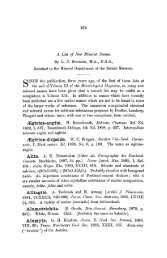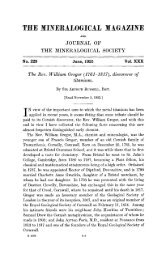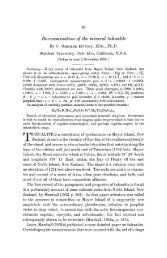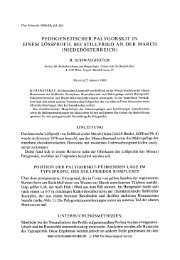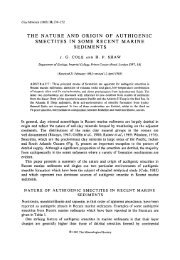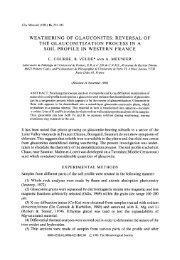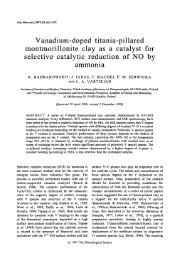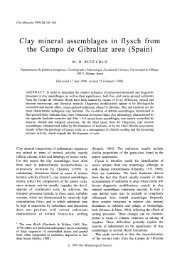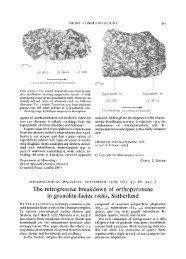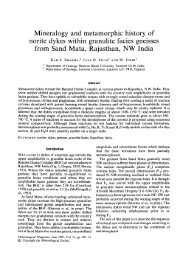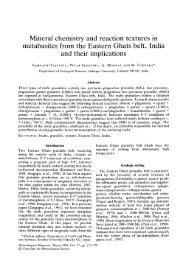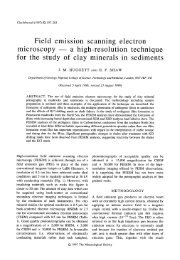The Blue coloration in banded fluorite (Blue John) from Castleton ...
The Blue coloration in banded fluorite (Blue John) from Castleton ...
The Blue coloration in banded fluorite (Blue John) from Castleton ...
You also want an ePaper? Increase the reach of your titles
YUMPU automatically turns print PDFs into web optimized ePapers that Google loves.
MINERALOGICAL MAGAZINE, JUNE I97 9, VOL. 43, PP. 243-50<br />
<strong>The</strong> <strong>Blue</strong> <strong>coloration</strong> <strong>in</strong> <strong>banded</strong> <strong>fluorite</strong><br />
(<strong>Blue</strong> <strong>John</strong>) <strong>from</strong> <strong>Castleton</strong>,<br />
Derbyshire, England<br />
A. K. GALWEY, 1 K. A. JONES, 2 R. REED 3<br />
1 Department of Chemistry, 2 Department of Geology, 3 <strong>The</strong> Electron Microscopy Laboratory, <strong>The</strong> Queen's<br />
University, Belfast BT7 INN, Northern Ireland<br />
AND<br />
D. DOLLIMORE<br />
Department of Chemistry and Applied Chemistry, University of Salford,<br />
Salford, M5 4WT, Lancashire, England<br />
s u M M A R Y. From the microscopic exam<strong>in</strong>ation of lightly<br />
etched, cleaved (I I I) surfaces of <strong>banded</strong> blue <strong>fluorite</strong><br />
(<strong>Blue</strong> <strong>John</strong>, <strong>from</strong> <strong>Castleton</strong>, Derbyshire) it is concluded<br />
that the coloured lamellae are not necessarily or exclusively<br />
associated with lattice-l<strong>in</strong>e imperfections. Elemental<br />
analyses, by electron dispersive methods, of fresh<br />
cleavage (I I I) surfaces <strong>in</strong> the immediate vic<strong>in</strong>ity of small<br />
<strong>in</strong>clusions (c. IO #m diameter) possess<strong>in</strong>g associated<br />
coloured haloes detected no appreciable concentrations<br />
of impurities. From the evidence available, it is suggested<br />
that the zones of blue colour consist of colloidal calcium<br />
result<strong>in</strong>g <strong>from</strong> radiation damage caused by the <strong>in</strong>termittent<br />
deposition of radioactive material on the surfaces<br />
of <strong>fluorite</strong> dur<strong>in</strong>g crystal development. <strong>The</strong> dispersion of<br />
colloidal calcium produced is particularly stable as a<br />
consequence of the close correspondence between lattice<br />
spac<strong>in</strong>gs <strong>in</strong> calcium fluoride and <strong>in</strong> calcium metal.<br />
THE unusual and aesthetically pleas<strong>in</strong>g <strong>banded</strong><br />
<strong>fluorite</strong>, often referred to as '<strong>Blue</strong> <strong>John</strong>', occurr<strong>in</strong>g<br />
near <strong>Castleton</strong> <strong>in</strong> Derbyshire has been the subject<br />
of long and cont<strong>in</strong>u<strong>in</strong>g <strong>in</strong>vestigations of the<br />
reasons for the strik<strong>in</strong>g blue <strong>coloration</strong>. Comparisons<br />
have been made with the properties of colourless<br />
material <strong>from</strong> the same location and, or,<br />
<strong>banded</strong> or colourless <strong>fluorite</strong>s <strong>from</strong> other widely<br />
scattered sources. However, despite many<br />
<strong>in</strong>vestigations no general agreement concern<strong>in</strong>g the<br />
identity of the chromophore has yet been reached<br />
perhaps partly because much of the experimental<br />
evidence has been negative <strong>in</strong> character. More<br />
possible explanations have been elim<strong>in</strong>ated than<br />
proposals positively proved.<br />
MacKenzie and Green (I97I) summarize the<br />
earlier literature concerned with <strong>Blue</strong> <strong>John</strong> and<br />
related <strong>fluorite</strong>s and identify the three general types<br />
Copyright the M<strong>in</strong>eralogical Society<br />
of chromophore that have been proposed to<br />
expla<strong>in</strong> the blue <strong>coloration</strong>. <strong>The</strong>se are <strong>in</strong>corporated<br />
hydrocarbon, <strong>in</strong>organic impurities, and lattice<br />
imperfections or damage produced mechanically<br />
or by radiation. <strong>The</strong>se workers applied the usual<br />
complementary chemical and physical techniques<br />
and conclude that the chief colour<strong>in</strong>g material is<br />
colloidal Ca, <strong>banded</strong> as a consequence of chang<strong>in</strong>g<br />
conditions dur<strong>in</strong>g m<strong>in</strong>eralization. Braithwaite et al.<br />
(I973) f<strong>in</strong>d no correlations between the distributions<br />
of colour and of either <strong>in</strong>organic or organic<br />
impurities <strong>in</strong> <strong>Blue</strong> <strong>John</strong> and related m<strong>in</strong>erals. <strong>The</strong>y<br />
conclude that physical rather than chemical factors<br />
are responsible for the <strong>coloration</strong> and suggest that<br />
colloidal particles of Ca have been formed by the<br />
aggregation of Ca atoms preferentially with<strong>in</strong> the<br />
more defective regions of the crystal. <strong>The</strong>se atoms<br />
are believed to have been released <strong>from</strong> the lattice<br />
dur<strong>in</strong>g long-term irradiation by radioactive elements,<br />
which are known to have been available by<br />
their cont<strong>in</strong>ued presence <strong>in</strong> associated uraniferous<br />
deposits (collophane).<br />
Calas (I972) concluded that colloidal Ca is not<br />
necessarily the colour<strong>in</strong>g matter <strong>in</strong> all <strong>banded</strong><br />
<strong>fluorite</strong>s and discusses the possible existence of<br />
alternative light-absorb<strong>in</strong>g centres conta<strong>in</strong><strong>in</strong>g <strong>in</strong>organic<br />
impurities, notably yttrium. Holgate<br />
(I973), <strong>from</strong> consideration of the dichroism of<br />
coloured <strong>fluorite</strong>s, believes that the most probable<br />
chromophore <strong>in</strong> <strong>Blue</strong> <strong>John</strong> is a hydrocarbon,<br />
though the particular compound or molecular<br />
group<strong>in</strong>g is not identified. Thus, <strong>from</strong> these and<br />
other recent reports, we must conclude that the<br />
light-absorb<strong>in</strong>g centres <strong>in</strong> coloured <strong>fluorite</strong> have<br />
not been positively and f<strong>in</strong>ally characterized and
244 A. K. GALWEY, ET AL.<br />
that the nature of the chromophores present<br />
rema<strong>in</strong>s a matter for active discussion.<br />
<strong>The</strong> present article reports a study of two aspects<br />
of the structure and composition of <strong>Blue</strong> <strong>John</strong>.<br />
Firstly, we have <strong>in</strong>vestigated the relationship between<br />
the distribution of lattice-l<strong>in</strong>e imperfections<br />
(dislocations) now present, as revealed by etch<strong>in</strong>g of<br />
cleaved surfaces, and the distribution of the blue<br />
<strong>coloration</strong>. This was <strong>in</strong>tended to determ<strong>in</strong>e whether<br />
direct support could be obta<strong>in</strong>ed for the theory that<br />
dispersed Ca <strong>in</strong> the bulk crystal was precipitated or<br />
aggregated <strong>in</strong> the form of a stable colloid preferentially<br />
with<strong>in</strong> defective zones. Although deformation<br />
and anneal<strong>in</strong>g under natural conditions could<br />
be expected to cause cont<strong>in</strong>u<strong>in</strong>g variations <strong>in</strong> lattice<br />
imperfection distribution, it was thought probable<br />
that extensive precipitation of colloidal material<br />
with<strong>in</strong> dislocations would stabilize them aga<strong>in</strong>st<br />
further movement. It seems <strong>in</strong>herently more likely<br />
that progressive dispersal of s<strong>in</strong>gle Ca atoms would<br />
occur more readily than the annihilation of the<br />
dislocation networks with<strong>in</strong> which such atoms were<br />
preferentially accommodated <strong>in</strong> the first place.<br />
Secondly, we have attempted to establish the<br />
composition of features hav<strong>in</strong>g the appearance of<br />
<strong>in</strong>clusions and which characteristically occurred <strong>in</strong><br />
irregular groups comprised of numerous <strong>in</strong>dividual<br />
members, each possess<strong>in</strong>g an associated zone of<br />
blue <strong>coloration</strong>. We have been unable to identify<br />
any foreign constituent and conclude that there are<br />
no appreciable local concentrations of any<br />
<strong>in</strong>cluded non-volatile impurity.<br />
In this article we also make brief reference to<br />
certa<strong>in</strong> other of our measurements. <strong>The</strong>se report no<br />
new <strong>in</strong>formation but are entirely consistent with<br />
and serve to confirm earlier observations by others.<br />
<strong>The</strong> nature of the colour centres result<strong>in</strong>g <strong>in</strong> the<br />
blue band<strong>in</strong>g and the manner of its production<br />
under natural conditions are discussed.<br />
Distribution of <strong>coloration</strong> <strong>in</strong> <strong>Blue</strong> <strong>John</strong><br />
<strong>The</strong> present study was exclusively concerned<br />
with samples of natural <strong>banded</strong> <strong>fluorite</strong> (<strong>Blue</strong> <strong>John</strong>)<br />
collected <strong>from</strong> a surface exposure directly above<br />
the entrance to Treak Cliff Cavern, near <strong>Castleton</strong>,<br />
Derbyshire (Nat. Grid Ref. SK 135 83I). From<br />
relatively perfect s<strong>in</strong>gle crystals (c. Io-3o mm l<strong>in</strong>ear<br />
dimensions) selected specimens were cleaved, by a<br />
sharp blow with a knife edge, <strong>in</strong>to th<strong>in</strong> plates<br />
suitable for microscopic exam<strong>in</strong>ation. Coloration<br />
<strong>in</strong> <strong>banded</strong> <strong>fluorite</strong> occurred <strong>in</strong> two characteristic<br />
distributions: <strong>in</strong> the form of planar lamellae and <strong>in</strong><br />
the immediate vic<strong>in</strong>ity of <strong>in</strong>dividual members of<br />
features hav<strong>in</strong>g the appearance of irregular groups<br />
of <strong>in</strong>clusions. <strong>The</strong>re were significant variations of<br />
hue, even with<strong>in</strong> a s<strong>in</strong>gle crystal fragment;<br />
perceived colours varied <strong>from</strong> p<strong>in</strong>k-magenta to<br />
dark blue. In addition to these readily recognizable<br />
patterns of colour distribution, with which we are<br />
particularly concerned here, there were also zones<br />
of less regular t<strong>in</strong>t<strong>in</strong>g, rang<strong>in</strong>g <strong>from</strong> what appeared<br />
to be lamellae of restricted extent to regions of illdef<strong>in</strong>ed<br />
outl<strong>in</strong>e conta<strong>in</strong><strong>in</strong>g no recognizable structure.<br />
It should be remembered that any explanation<br />
of the <strong>coloration</strong>, based on consideration of the<br />
properties of representative lamellae and the most<br />
concentrated groups of po<strong>in</strong>t features with associated<br />
haloes, must also be capable of account<strong>in</strong>g<br />
for the existence of the ill-def<strong>in</strong>ed and more diffuse<br />
regions of t<strong>in</strong>t<strong>in</strong>g.<br />
Lamellae of <strong>coloration</strong>. Planar lamellae of <strong>coloration</strong>,<br />
many be<strong>in</strong>g c. o.I mm thickness, obliquely<br />
traverse the th<strong>in</strong> plates (o.2-1.o mm) of <strong>fluorite</strong><br />
prepared for exam<strong>in</strong>ation by parallel cleavages at<br />
the (i I I) plane. This appearance is consistent with<br />
the production of the th<strong>in</strong> coloured lamellae at<br />
crystal planes parallel to cubic growth faces, dur<strong>in</strong>g<br />
or follow<strong>in</strong>g addition of CaF2 <strong>in</strong> m<strong>in</strong>eralization:<br />
natural deposits of <strong>fluorite</strong> are often produced <strong>in</strong><br />
the form of assemblages of <strong>in</strong>tergrown cubes, for<br />
which the (ioo) faces predom<strong>in</strong>ate. Growth directions,<br />
and their relict structures, therefore, appear<br />
as planes orientated at 54 ~ 44' to the strongly<br />
preferred (Ill) fracture direction of the <strong>fluorite</strong><br />
crystal.<br />
Assemblages of <strong>in</strong>clusions. Slivers of <strong>fluorite</strong>,<br />
obta<strong>in</strong>ed on cleavage, occasionally conta<strong>in</strong>ed zones<br />
of irregular dispositions of large numbers of small<br />
features provisionally identified as <strong>in</strong>clusions. <strong>The</strong><br />
<strong>in</strong>dividual members of these assemblages were too<br />
small (diameters c. Io/zm) to permit the resolution<br />
of detail by optical microscopy. In some places each<br />
opaque zone was surrounded by an <strong>in</strong>dist<strong>in</strong>ct blue<br />
halo.<br />
L<strong>in</strong>e dislocations <strong>in</strong> <strong>Blue</strong> <strong>John</strong><br />
<strong>The</strong> preferential dissolution of crystal surfaces<br />
<strong>in</strong>itiated <strong>in</strong> the vic<strong>in</strong>ity of imperfections has been<br />
widely used as a method of locat<strong>in</strong>g po<strong>in</strong>ts of<br />
<strong>in</strong>tersection of l<strong>in</strong>e dislocations with surfaces. Prelim<strong>in</strong>ary<br />
work with the present m<strong>in</strong>eral showed<br />
that triangular etch pits were developed after<br />
c. 2 m<strong>in</strong> dissolution <strong>in</strong> IO ~o aqueous hydrochloric<br />
acid at c. 35 ~ K. An unidentified deposit produced<br />
<strong>in</strong> this treatment was removed <strong>from</strong> etched surfaces<br />
by wash<strong>in</strong>g with hot distilled water before<br />
microscopic exam<strong>in</strong>ation or analysis.<br />
About twenty different th<strong>in</strong> cleaved (i i i) plates<br />
of <strong>Blue</strong> <strong>John</strong>, each specimen hav<strong>in</strong>g been selected to<br />
<strong>in</strong>clude at least one strongly coloured lamella, were<br />
<strong>in</strong>dividually etched under an appropriate range of<br />
conditions (of severities greater than and also less<br />
than the optimum) and the treated surfaces<br />
exam<strong>in</strong>ed <strong>in</strong> detail <strong>in</strong> a scann<strong>in</strong>g electron microscope.<br />
This technique has the disadvantage that the
BLUE COLORATION IN BANDED FLUORITE 245<br />
precise position of the coloured zone does not<br />
appear on the image, but it was possible to prepare<br />
overlapp<strong>in</strong>g sequences of photographs of areas of<br />
<strong>in</strong>terest for comparison with features identified and<br />
located <strong>in</strong> a previous optical exam<strong>in</strong>ation. A<br />
representative composite photograph of an<br />
etched surface is shown <strong>in</strong> fig. I, for which it<br />
was <strong>in</strong>dependently known that a blue lamella<br />
FIGS. I and 2: FIe;. I (above). Texture of(III) cleavage<br />
surtace of <strong>Blue</strong> <strong>John</strong> etched briefly with Io o; aqueous<br />
hydrochloric acid at c. 35o K. A blue lamella, aligned <strong>in</strong><br />
the direction shown by the arrow, <strong>in</strong>tersected the surface<br />
somewhere between the limits given by the horizontal<br />
white l<strong>in</strong>es. None of the several aligned etch features<br />
could be positively ascribed to the presence of the<br />
coloured zone. SEM photograph. FIG. 2 (right). Typical<br />
<strong>in</strong>clusions found on (I ~ I) cleavage surfaces of <strong>Blue</strong> <strong>John</strong>:<br />
both examples occurred on faces exposed by the vigorous<br />
disruption of the m<strong>in</strong>eral on heat<strong>in</strong>g at 750 K. SEM<br />
photogra)h.
246 A. K. GALWEY, ET AL.<br />
<strong>in</strong>tersected the surface as a horizontal band (of<br />
unknown width) somewhere between the limits<br />
shown (as horizontal l<strong>in</strong>es). No feature of the<br />
etched surface could be correlated with the zone<br />
of blue <strong>coloration</strong>.<br />
Etch<strong>in</strong>g <strong>in</strong>variably revealed the presence of<br />
alignments of crystallographic imperfections,<br />
which appeared as l<strong>in</strong>ear troughs apparently composed<br />
of closely spaced, overlapp<strong>in</strong>g triangular<br />
etch pits. Dimensions of such troughs were significantly<br />
less than the thicknesses of the coloured<br />
lamellae. While, <strong>in</strong> some <strong>in</strong>stances, etch pit alignments<br />
co<strong>in</strong>cided with known positions of blue<br />
zones, <strong>in</strong> other examples no such correlation was<br />
evident and elsewhere, aga<strong>in</strong>, l<strong>in</strong>ear pattems of etch<br />
pits were present <strong>in</strong> places remote <strong>from</strong> any <strong>coloration</strong>.<br />
Thus, blue lamellae cannot be identified with<br />
the presence of l<strong>in</strong>e imperfections, lattice disorder,<br />
or <strong>in</strong>creased surface reactivity result<strong>in</strong>g <strong>in</strong> any<br />
significant enhancement of the local rate of salt<br />
dissolution.<br />
While it is possible that extensive redistribution<br />
and perhaps removal of dislocations may have<br />
occurred dur<strong>in</strong>g the post-depositional <strong>in</strong>terval, it<br />
was none the less unexpected that there was no<br />
evidence of an enhanced, or even changed reactivity<br />
of the crystal <strong>in</strong> the vic<strong>in</strong>ity of blue zones. This<br />
would appear to suggest that the crystal lattice<br />
with<strong>in</strong> the lamellae does not now conta<strong>in</strong> high<br />
concentrations of l<strong>in</strong>e imperfections or impurities.<br />
If it is believed (Braithwaite et al., 1973) that the<br />
colour band<strong>in</strong>g arose as a consequence of the<br />
dislocation net provid<strong>in</strong>g sites for the preferential<br />
aggregation of Ca particles of colloidal dimensions<br />
<strong>from</strong> atoms released by radiation damage with<strong>in</strong><br />
the crystal bulk, it is difficult to expla<strong>in</strong> how such<br />
an impurity-laden and locked network could have<br />
been reorganized without achiev<strong>in</strong>g conditions of<br />
sufficient severity to either redisperse the Ca as<br />
atoms or permit its cont<strong>in</strong>ued aggregation with<strong>in</strong><br />
the imperfect zones. It is also necessary, on this<br />
model, to make the additional assumption that the<br />
trapped colloid has particular stability, s<strong>in</strong>ce<br />
coloured <strong>fluorite</strong>s <strong>from</strong> several dist<strong>in</strong>ct sources give<br />
(MacKenzie and Green, I97I) rather similar<br />
spectra, presumably attributable to the presence of<br />
particles with<strong>in</strong> the same size range.<br />
From this evidence, therefore, we conclude that,<br />
s<strong>in</strong>ce the imperfection structure assumed to have<br />
been present dur<strong>in</strong>g colloidal particle development<br />
is not now detectable, the ma<strong>in</strong>ta<strong>in</strong>ed colour<br />
distribution <strong>in</strong> bands cannot be ascribed to the<br />
formation of a colloidal dispersion of Ca metal <strong>in</strong> a<br />
preferred size range result<strong>in</strong>g <strong>from</strong> Ca atom<br />
aggregation exclusively with<strong>in</strong> a pre-exist<strong>in</strong>g and,<br />
<strong>in</strong> places, highly <strong>in</strong>homogeneous, distribution of<br />
lattice imperfections.<br />
Assemblages of <strong>in</strong>clusions <strong>in</strong> <strong>Blue</strong> <strong>John</strong><br />
Representative small opaque zones, each with an<br />
associated blue halo, were exam<strong>in</strong>ed <strong>in</strong> an attempt<br />
to identify any <strong>in</strong>cluded material, s<strong>in</strong>ce this could<br />
give evidence of the composition of substances<br />
present dur<strong>in</strong>g hydrothermal deposition of the<br />
m<strong>in</strong>eral. Optical microscopy yielded no useful<br />
<strong>in</strong>formation and it was difficult to ascerta<strong>in</strong><br />
whether the very small opaque spots (< IO pm) of<br />
<strong>in</strong>terest were exposed at the surfaces of samples<br />
cleaved for stereoscan exam<strong>in</strong>ation, even for<br />
crystals conta<strong>in</strong><strong>in</strong>g locally dense concentrations of<br />
these features. Accord<strong>in</strong>gly, numerous comparisons<br />
were made between stereoscan pictures of<br />
cleavage surfaces travers<strong>in</strong>g <strong>in</strong>clusion-rich regions<br />
and those <strong>from</strong> clear <strong>fluorite</strong>. <strong>The</strong> only general<br />
conclusion to emerge <strong>from</strong> this comparison was<br />
that there was an enhanced <strong>in</strong>cidence of pitt<strong>in</strong>g <strong>in</strong><br />
areas <strong>from</strong> the <strong>in</strong>clusion-rich material. Some representative<br />
pits are shown <strong>in</strong> fig. 2. We believe,<br />
therefore, that the opaque spots were holes with<strong>in</strong><br />
the crystal filled with a gas or volatile liquid. <strong>The</strong><br />
<strong>in</strong>teriors, edges, and immediate vic<strong>in</strong>ities of upwards<br />
of IOO of these holes, and, <strong>in</strong> addition, such<br />
rare atypical surface features as were noted, were<br />
analysed by the EDAX method (Energy Dispersive<br />
Analysis of Xrays: Edax International). <strong>The</strong> only<br />
element (of atomic number > I5) present was Ca,<br />
though one or two <strong>in</strong>stances of the presence of Fe <strong>in</strong><br />
trace amounts and at the lower limits of detection<br />
were <strong>in</strong>dicated. <strong>The</strong>re was no evidence, therefore,<br />
that elements, held <strong>in</strong> any solution that was conta<strong>in</strong>ed<br />
with<strong>in</strong> these <strong>in</strong>clusions, were deposited on<br />
solvent evaporation. We cannot be certa<strong>in</strong> <strong>from</strong><br />
our observations that <strong>in</strong>cluded m<strong>in</strong>erals conta<strong>in</strong><strong>in</strong>g<br />
A1, O, Si (etc.) were entirely absent. We can be sure,<br />
however, <strong>from</strong> detailed consideration of data for<br />
both typical and atypical areas of representative<br />
cleaved surfaces that all analytical results were<br />
entirely consistent with the view that the m<strong>in</strong>eral<br />
was pure calcium fluoride. Aga<strong>in</strong>, with<strong>in</strong> the very<br />
few zones of exceptional texture found, it was<br />
apparent <strong>from</strong> EDAX analyses that calcium was<br />
the preponderant, possibly exclusive, cation.<br />
Crystals heated to c. 70o-8oo K (below the<br />
temperature at which colour is completely lost:<br />
some aspects of thermal bleach<strong>in</strong>g are discussed by<br />
Braithwaite et al., I973) disrupted violently with<br />
preferred cleavage at (I I I) planes. Stereoscan<br />
exam<strong>in</strong>ation showed that the surfaces exposed<br />
were rich <strong>in</strong> pits and EDAX analysis aga<strong>in</strong> confirmed<br />
that calcium was apparently the exclusive<br />
surface cation. Surface pits were not <strong>in</strong>variably<br />
associated with colour and the exposure of such<br />
features on heat<strong>in</strong>g suggests that disruption of the<br />
crystal may be a consequence of pressure developed
BLUE COLORATION IN BANDED FLUORITE 247<br />
by fluid with<strong>in</strong> the <strong>in</strong>clusion at elevated temperature.<br />
A more precise application of the same general<br />
approach to the chemical identification of <strong>in</strong>cluded<br />
material was made by select<strong>in</strong>g for exam<strong>in</strong>ation a<br />
s<strong>in</strong>gle relatively large, separate, and dist<strong>in</strong>ct <strong>in</strong>clusion,<br />
e. 1o pm diameter, surrounded by a coloured<br />
halo, c. 8/~m thickness. <strong>The</strong> <strong>fluorite</strong> overlay<strong>in</strong>g this<br />
structure was gently removed by systematically<br />
f<strong>in</strong>er polish<strong>in</strong>g until the dark spot was adjudged by<br />
optical microscopic exam<strong>in</strong>ation to be at the<br />
m<strong>in</strong>eral surface. This crystal was then mounted <strong>in</strong><br />
an electron microprobe and the beam (accurately<br />
located by the <strong>in</strong>tentional production of a blue spot<br />
on the surface at a po<strong>in</strong>t somewhat removed <strong>from</strong><br />
the feature of <strong>in</strong>terest) was focused on the centre of<br />
the selected <strong>in</strong>clusion prepared for exam<strong>in</strong>ation.<br />
Analytical scans were made extend<strong>in</strong>g across the<br />
complete spectrum available (3o-i3 o~ for three<br />
crystal analysers: lithium fluoride, quartz, and<br />
KAP. In addition, specific impurities were sought.<br />
No perceptable concentration of any element other<br />
than Ca was detected, <strong>from</strong> which it is concluded<br />
that the local concentrations of impurities (atomic<br />
number > IO) were all < o.I ~. <strong>The</strong> same result<br />
was obta<strong>in</strong>ed for two further selected <strong>in</strong>clusions,<br />
similarly exposed on the surface and analysed.<br />
Electron microprobe analyses at each of a l<strong>in</strong>ear<br />
sequence of surface po<strong>in</strong>ts extend<strong>in</strong>g across the<br />
zone of <strong>in</strong>tersection of a blue band with a cleavage<br />
face gave no evidence of the presence of any<br />
detectable quantities of the follow<strong>in</strong>g possible<br />
impurities: Fe, K, Mn, P, S, Si, Sr, U, or Y. <strong>The</strong> only<br />
major response was (aga<strong>in</strong>) for Ca and, <strong>in</strong>deed, the<br />
<strong>in</strong>dications were that the concentration of this<br />
element was perhaps marg<strong>in</strong>ally greater (by<br />
< 0.5 ~o) with<strong>in</strong> the blue band. While this apparent<br />
local enhancement of concentration is too small to<br />
be accepted as reliable, it does confirm that there is<br />
not a dim<strong>in</strong>ished concentration of Ca a+ with<strong>in</strong> the<br />
coloured zone; this is, perhaps, the most probable<br />
consequence of the presence of cationic impurities.<br />
Other measurements<br />
Other of our measurements agree with, and serve<br />
to confirm, conclusions published elsewhere; relevant<br />
experimental data which we have obta<strong>in</strong>ed<br />
may be briefly mentioned:<br />
<strong>The</strong> <strong>coloration</strong> was not removed on boil<strong>in</strong>g<br />
crushed <strong>Blue</strong> <strong>John</strong> with organic or <strong>in</strong>organic<br />
(aqueous NaOH, HC1, or H2SO4) solvents. Lattice<br />
spac<strong>in</strong>gs, measured by X-ray diffraction, for blue<br />
and for colourless material were <strong>in</strong>dist<strong>in</strong>guishable.<br />
<strong>The</strong> absorption spectrum (MacKenzie and Green,<br />
I97I) <strong>in</strong>cluded a broad band between 55o-6oo nm,<br />
but no useful <strong>in</strong>formation could be obta<strong>in</strong>ed <strong>from</strong><br />
electron sp<strong>in</strong> resonance and proton sp<strong>in</strong> resonance<br />
spectra.<br />
X-ray fluorescence spectral analysis of powdered<br />
samples revealed no detectable difference <strong>in</strong> impurity<br />
concentrations between coloured and<br />
colourless <strong>Blue</strong> <strong>John</strong>; approximate amounts detected<br />
were Sr 25, Fe I5, Y Io, and Mn 25 ppm.<br />
Combustion analyses gave H o.15 and C o.35~.<br />
Mass spectral analysis, us<strong>in</strong>g an AEI MS9o2 <strong>in</strong>strument,<br />
for the immediate analyses of the volatile<br />
products obta<strong>in</strong>ed on vacuum heat<strong>in</strong>g of <strong>Blue</strong> <strong>John</strong><br />
to 700-50 ~ identified only H20, CO, and CO2.<br />
Although the background response of the <strong>in</strong>strument<br />
with<strong>in</strong> the mass range Ioo-4o was generally<br />
<strong>in</strong>creased dur<strong>in</strong>g sample heat<strong>in</strong>g, no significant<br />
quantity of any identifiable product was detected<br />
with<strong>in</strong> the mass range Ioo-25o. Helium, a possible<br />
product of radioactive decay, was sought, but not<br />
found, <strong>in</strong> the gases released on heat<strong>in</strong>g the m<strong>in</strong>eral<br />
to 800 ~ <strong>The</strong>re was no <strong>in</strong>dication of the formation<br />
of any detectable (i.e. < Io -9 mol g-~ or<br />
o.ooooI ~) quantity of organic products <strong>in</strong> the<br />
C4-C~ o hydrocarbon boil<strong>in</strong>g range by the thermal<br />
desorption method (Galwey, I965), on heat<strong>in</strong>g<br />
various samples of <strong>Blue</strong> <strong>John</strong> to the temperature at<br />
which the colour was lost, c. 77 ~ ~<br />
DISCUSSION<br />
Previous studies, together with limited observations<br />
with<strong>in</strong> the present work, have shown that the<br />
bulk composition of the coloured <strong>fluorite</strong> zones is<br />
<strong>in</strong>dist<strong>in</strong>guishable <strong>from</strong> that of the colourless<br />
m<strong>in</strong>eral. Our attempts here to identify any highly<br />
localized compositional changes that might be<br />
associated with microstructural anomalies or <strong>in</strong>clusions<br />
(dimensions c. 5 /~m upwards) have been<br />
unable to detect the existence of any variations <strong>in</strong><br />
composition, or impurity aggregation, capable of<br />
account<strong>in</strong>g for the <strong>coloration</strong>. Ca was virtually the<br />
only element detected by the techniques employed.<br />
<strong>The</strong>se analytical <strong>in</strong>vestigations were conducted<br />
<strong>in</strong> conjunction with etch<strong>in</strong>g studies of cleaved<br />
surfaces, which revealed, <strong>from</strong> the pattern of etch<br />
pit development, that l<strong>in</strong>e imperfections were distributed<br />
throughout the crystal and dislocations<br />
were not associated with either lamellae of <strong>coloration</strong><br />
or assemblages of <strong>in</strong>clusions. From this we<br />
conclude that structures with<strong>in</strong> t<strong>in</strong>ted zones were<br />
generally similar to those elsewhere and that the<br />
chromophores are accommodated with<strong>in</strong> a zone of<br />
relatively perfect crystal, conta<strong>in</strong><strong>in</strong>g no recognizable<br />
lattice distortion features.<br />
<strong>The</strong> available evidence, therefore, <strong>in</strong>dicates that<br />
<strong>Blue</strong> <strong>John</strong> is a remarkably pure and homogeneous<br />
<strong>fluorite</strong>. Bulk and local concentrations of impurities<br />
are probably too low to account for the
248 A. K. GALWEY, ET AL.<br />
observed absorption spectrum. No compositional<br />
feature, local reactivity variation (etch<strong>in</strong>g), textural<br />
anomaly, lattice imperfection or characteristic<br />
microstructure capable of account<strong>in</strong>g for the<br />
<strong>coloration</strong> was recognized. We, therefore, conclude,<br />
with other authors (MacKenzie and Green,<br />
I971; Braithwaite et al., 1973), that the blue <strong>coloration</strong><br />
is due to the presence of colloidal Ca, though<br />
we propose below explanations for the development<br />
of the band<strong>in</strong>g and for the structure of this<br />
colloid that are somewhat different <strong>from</strong> those<br />
previously advanced.<br />
Development of <strong>banded</strong> <strong>coloration</strong> <strong>in</strong> <strong>Blue</strong> <strong>John</strong><br />
Our observation that the blue <strong>coloration</strong> is not<br />
consistently correlated with the exist<strong>in</strong>g distribution<br />
of l<strong>in</strong>e dislocations with<strong>in</strong> the m<strong>in</strong>eral leads us<br />
to reject (see above) the suggested explanation<br />
(Braithwaite et al., I973) that band<strong>in</strong>g arises because<br />
Ca atoms released <strong>in</strong> the crystal bulk (dur<strong>in</strong>g<br />
irradiation by a radioactive material, e.g. U) segregate<br />
by aggregation as colloidal particles preferentially<br />
located with<strong>in</strong> zones of imperfection,<br />
<strong>banded</strong> and oriented <strong>in</strong> the (ioo) direction. We<br />
prefer an explanation <strong>in</strong>vok<strong>in</strong>g <strong>in</strong>termittent local<br />
superficial radiation damage to the <strong>fluorite</strong> crystals<br />
dur<strong>in</strong>g <strong>in</strong>terruptions to their hydrothermal growth<br />
(Per<strong>in</strong>g, I973). M<strong>in</strong>eral development through<br />
advance of the cubic faces of the grow<strong>in</strong>g crystal is<br />
envisaged as proceed<strong>in</strong>g by acquisition of CaF2<br />
<strong>from</strong> a cool<strong>in</strong>g solution, also conta<strong>in</strong><strong>in</strong>g a soluble<br />
radioactive substance (U), which is later deposited.<br />
Dur<strong>in</strong>g this period a th<strong>in</strong> layer of the external<br />
<strong>fluorite</strong> surface suffered some radiation damage<br />
before the arrival of a further pulse of hot m<strong>in</strong>eraliz<strong>in</strong>g<br />
solution. This rapidly redissolved the radioactive<br />
material, perhaps also some <strong>fluorite</strong>, before<br />
cool<strong>in</strong>g to the po<strong>in</strong>t at which CaF2 deposition,<br />
crystal growth, was resumed, cover<strong>in</strong>g and protect<strong>in</strong>g<br />
the damaged (IOO) planar zone. Intermittent<br />
repetition of such cycles accounts for the irregular<br />
patterns of blue planar zones, parallel, but of<br />
vary<strong>in</strong>g <strong>in</strong>tensity, the presence of <strong>in</strong>complete bands<br />
(as a consequence of uneven dissolution) and the<br />
absence of reta<strong>in</strong>ed radioactive material. On this<br />
model radiation damage is of limited thickness and<br />
crystal anneal<strong>in</strong>g may occur by local and limited<br />
ionic movements, which largely restore the perfection<br />
of the lattice, envelop<strong>in</strong>g and protect<strong>in</strong>g the<br />
<strong>in</strong>corporated crystallites of the colloidal dispersion.<br />
<strong>The</strong>re is little reduction of crystal coherence along<br />
planes of blue <strong>coloration</strong> s<strong>in</strong>ce dis<strong>in</strong>tegration does<br />
not preferentially propagate with<strong>in</strong> the chromophore-rich<br />
lam<strong>in</strong>ae. This last important property of<br />
<strong>Blue</strong> <strong>John</strong> does not seem to have been adequately<br />
considered by those who identify the chromophore<br />
as large organic molecules. <strong>The</strong> required concentrations<br />
of such impurities, disposed on orig<strong>in</strong>al<br />
growth (ioo) surfaces, would result <strong>in</strong> an appreciable<br />
reduction <strong>in</strong> hardness and so the crystal would<br />
more easily break <strong>in</strong> this direction, unless the<br />
impurity forms bonds with the host lattice.<br />
<strong>The</strong> <strong>in</strong>dist<strong>in</strong>ct local zones of blue, apparently<br />
associated with small <strong>in</strong>clusions, are not readily<br />
accounted for on this, or, <strong>in</strong>deed, most other simple<br />
explanations. It is difficult to provide a realistic<br />
model for such <strong>in</strong>clusions, s<strong>in</strong>ce detailed structures<br />
of the features could not be resolved by optical<br />
microscopy and no evidence of impurity retention<br />
could be obta<strong>in</strong>ed. <strong>The</strong> most acceptable representation<br />
that we can propose at present is that the<br />
temporary residence of particles of sediment <strong>in</strong>terrupted<br />
crystal growth locally, radioactive constituents<br />
result<strong>in</strong>g <strong>in</strong> damage to the <strong>fluorite</strong> <strong>in</strong> the<br />
immediate vic<strong>in</strong>ity of the rest<strong>in</strong>g fragment. Such<br />
deposited material was not, however, itself <strong>in</strong>cluded<br />
with<strong>in</strong> the grow<strong>in</strong>g m<strong>in</strong>eral <strong>in</strong> analytically detectable<br />
amounts, though the temporary residence of<br />
such particles may have <strong>in</strong>hibited (or poisoned, by<br />
monolayer deposition) local surface advance sufficiently<br />
to result <strong>in</strong> the formation of some (solventfilled?)<br />
<strong>in</strong>clusions.<br />
This general model is consistent with the view<br />
(Stevenson and Gaunt, I971) that <strong>Blue</strong> <strong>John</strong> was<br />
developed <strong>in</strong> its present position earlier than the<br />
ma<strong>in</strong> m<strong>in</strong>eralization phase of the region s<strong>in</strong>ce it<br />
tends to occur <strong>in</strong> cavities and pipe vents rather than<br />
<strong>in</strong> the ve<strong>in</strong>s proper.<br />
Structure of colloidal Ca <strong>in</strong> <strong>Blue</strong> <strong>John</strong><br />
In the observations reported above, we have<br />
obta<strong>in</strong>ed no direct <strong>in</strong>formation concern<strong>in</strong>g the<br />
sizes, shapes, relative dispositions, concentrations,<br />
or structures oftbe colloidal particles of Ca that we<br />
believe to be responsible for the <strong>coloration</strong> of <strong>Blue</strong><br />
<strong>John</strong>, except that the dimensions were below the<br />
limits of resolution of the techniques available to<br />
us. <strong>The</strong> only relevant <strong>in</strong>formation would appear to<br />
be the absence of a Tyndall effect (Braithwaite et al.,<br />
I973), <strong>in</strong>dicat<strong>in</strong>g that the average diameter of the<br />
colloidal particles is < 3o nm.<br />
<strong>The</strong> possible structure of colloidal Ca <strong>in</strong> <strong>fluorite</strong><br />
is appropriately discussed with reference to recent<br />
observations and conclusions concern<strong>in</strong>g radiation<br />
damage <strong>in</strong> CaF 2 by Chadderton et al. (I976a, b).<br />
<strong>The</strong>se workers have subjected calcium fluoride<br />
crystals to a very high flux electron bombardment<br />
and found that <strong>in</strong>stead of complete dis<strong>in</strong>tegration,<br />
as might have been anticipated, complicated lattice<br />
reorganizations occurred, lead<strong>in</strong>g to new structures<br />
of considerable stability. <strong>The</strong>re was fluoride ion<br />
migration <strong>in</strong> the anionic sub-lattice and <strong>in</strong>terstitials
BLUE COLORATION IN BANDED FLUORITE 249<br />
became trapped at bubbles of fluor<strong>in</strong>e gas. Concurrently<br />
cations were transformed <strong>in</strong>to Ca crystallites,<br />
coherent with the matrix and provid<strong>in</strong>g<br />
nucleation centres for the anionic voids. <strong>The</strong> significant<br />
and perhaps unique feature of this metal<br />
production process (presumably also relevant to<br />
the production of chromophores, colloidal Ca, <strong>in</strong><br />
the coloured natural <strong>fluorite</strong>) was that the cubic<br />
lattice of Ca metal could be accommodated with<strong>in</strong><br />
the (cubic) <strong>fluorite</strong> lattice with a m<strong>in</strong>imum of<br />
stra<strong>in</strong>, s<strong>in</strong>ce the unit cell edge of Ca metal is but<br />
2. I ~/o greater than that of calcium fluoride,<br />
We do not <strong>in</strong>tend to suggest that the radiation<br />
damage that resulted <strong>in</strong> colour development <strong>in</strong> <strong>Blue</strong><br />
<strong>John</strong>, or any other coloured natural <strong>fluorite</strong>,<br />
approached the severity of conditions that<br />
occurred dur<strong>in</strong>g the electron-microscope experiments<br />
referred to above. <strong>The</strong> po<strong>in</strong>t relevant to the<br />
present discussion, however, is that, unlike most<br />
other substances, lattice reorganization follow<strong>in</strong>g<br />
irradiation can generate a Ca metal dispersion of<br />
particular stability, coherently accommodated<br />
with<strong>in</strong> the host CaF2 lattice with a m<strong>in</strong>imum of<br />
stra<strong>in</strong>. Metal enveloped with<strong>in</strong> the stable, wellcrystallized,<br />
and <strong>in</strong>soluble m<strong>in</strong>eral may be expected<br />
to be unreactive and protected <strong>from</strong> chemical<br />
change dur<strong>in</strong>g geological periods of time. It is<br />
reasonable to suppose that <strong>in</strong> such a dispersion<br />
there would be a particle size range of preferred<br />
stability <strong>in</strong>fluenced (<strong>in</strong>ter alia) by stra<strong>in</strong> energy due<br />
to molar volume differences (lattice spac<strong>in</strong>gs do not<br />
constitute an exact match) and stra<strong>in</strong> at the Ca-<br />
CaF2 <strong>in</strong>terface, which is <strong>in</strong>sufficient to cause a<br />
marked reduction <strong>in</strong> crystal coherence with<strong>in</strong><br />
colloid-conta<strong>in</strong><strong>in</strong>g (coloured) zones. Properties of<br />
the stable colloid, <strong>in</strong>clud<strong>in</strong>g metal particle size, are,<br />
therefore, controlled by spac<strong>in</strong>gs and elastic constants<br />
of the constituent phases. This expla<strong>in</strong>s the<br />
occurrence of broadly similar t<strong>in</strong>t<strong>in</strong>g of <strong>fluorite</strong><br />
obta<strong>in</strong>ed <strong>from</strong> widely differ<strong>in</strong>g localities, while<br />
m<strong>in</strong>or differences <strong>in</strong> colloid dimensions account for<br />
variations <strong>in</strong> spectra and colours. In contrast, it is<br />
not evident that the growth of metal at zones of<br />
imperfection <strong>from</strong> atoms released <strong>in</strong> the bulk under<br />
the <strong>in</strong>fluence of radiation would yield particles<br />
with<strong>in</strong> a preferred size <strong>in</strong>terval.<br />
Although it might be expected that coloured<br />
bands, radiation-<strong>in</strong>duced by this mechanism,<br />
would reduce <strong>in</strong> <strong>in</strong>tensity with distance <strong>from</strong> the<br />
source (and we are <strong>in</strong>debted to a referee for this<br />
suggestion), this possibility could not be <strong>in</strong>vestigated<br />
by direct measurement s<strong>in</strong>ce the blue lamellae<br />
were too th<strong>in</strong>. It was our qualitative impression,<br />
however, that both bound<strong>in</strong>g surfaces of coloured<br />
zones were relatively sharp. Moreover, we are<br />
aware of no reliable method of predict<strong>in</strong>g the<br />
variation <strong>in</strong> optical density with depth of radiation<br />
penetration for the complicated physical and<br />
chemical processes <strong>in</strong>volved <strong>in</strong> the production of<br />
the stable colloid. It seems to us probable that<br />
crystal damage with<strong>in</strong> the coloured lamellae at<br />
distances furthest <strong>from</strong> the source must arise <strong>in</strong> an<br />
asymmetric radiation field and, if this results <strong>in</strong> the<br />
generation of asymmetric colloidal particles, an<br />
explanation of the existence of the dichroic (Holgate,<br />
I973) effect is provided.<br />
<strong>The</strong> model proposed above, therefore, provides<br />
an acceptable explanation of the chromophore,<br />
consistent with available <strong>in</strong>formation and not <strong>in</strong><br />
conflict with previous observations reported <strong>in</strong> the<br />
literature. It is suggested that lattice reorganization<br />
follow<strong>in</strong>g radiation damage, by anneal<strong>in</strong>g through<br />
relatively short-distance migrations, removes most<br />
large imperfections <strong>from</strong> the lattice and no exceptional<br />
concentration of dislocations rema<strong>in</strong>s at the<br />
blue zones.<br />
CONCLUSIONS<br />
We conclude, therefore, that the <strong>banded</strong> blue<br />
<strong>coloration</strong> <strong>in</strong> <strong>Blue</strong> <strong>John</strong> represents zones of radiation<br />
damage, produced dur<strong>in</strong>g the <strong>in</strong>termittent but<br />
temporary deposition of radioactive material at the<br />
grow<strong>in</strong>g cubic faces of <strong>fluorite</strong> m<strong>in</strong>eral. Local<br />
damage <strong>in</strong> a th<strong>in</strong> surface layer, dur<strong>in</strong>g and follow<strong>in</strong>g<br />
passage of this radiation, resulted <strong>in</strong> the aggregation<br />
of fluor<strong>in</strong>e as gas bubbles and the generation<br />
of small accumulations of metal atoms coherently<br />
accommodated with<strong>in</strong> reorganized crystals of<br />
<strong>fluorite</strong>. Dur<strong>in</strong>g this recrystallization, local concentrations<br />
of lattice imperfections were reduced.<br />
<strong>The</strong> colloidal particles of metal were of a preferred<br />
size range, of particular stability, and protected<br />
with<strong>in</strong> a relatively unreactive matrix. This explanation<br />
is based on the properties of the <strong>fluorite</strong> lattice<br />
(s<strong>in</strong>ce the conditions that obta<strong>in</strong>ed dur<strong>in</strong>g deposition<br />
of the m<strong>in</strong>eral cannot now be verified directly)<br />
and possesses the important feature that it does<br />
not require the participation of impurities and,<br />
or, structures, the presence of which it has proved<br />
so difficult to demonstrate.<br />
Acknowledgements. <strong>The</strong> authors thank Mr Ian Meighan<br />
for assistance <strong>in</strong> the determ<strong>in</strong>ation of trace impurities <strong>in</strong><br />
the bulk sample.<br />
REFERENCES<br />
Braithwaite (R. S. W.), Flowers (W. T.), Haszeld<strong>in</strong>e<br />
(R. N.), and Russell (M.), I973. M<strong>in</strong>eral. Mag. 39,<br />
40I-I I.<br />
Calas (G.), I972. Ibid. 38, 977-9.<br />
Chadderton (L. T.), <strong>John</strong>son (E.), and Wohlenberg (T.),<br />
I976a. Radiation Effects, 28, I I I-I2.
z5o<br />
A. K. GALWEY, ET AL.<br />
Chadderton (L. T.), <strong>John</strong>son (E), and Wohlenberg (T.),<br />
i976b. Physica Scripta, 13, I27-8; Monographs 76-o8,<br />
76-IZ of Fysisk Laboratorium l I, Orsted Institute,<br />
KCbenhavns Universitet.<br />
Galwey (A. K.), I965. Proceed<strong>in</strong>gs 3rd International<br />
Congress on Catalysis, Amsterdam, North-Holland,<br />
Amsterdam, 79I-8O3 .<br />
--I965. J. Catalysis, 4, 34-42.<br />
Holgate (N.), I973. M<strong>in</strong>eral. Mag. 39, 363-6.<br />
MacKenzie (K. J. D.) and Green (J. M.), I97I. Ibid. 38,<br />
459-7o.<br />
Per<strong>in</strong>g (K. L.), I973. Geochim. Cosmochim. Acta, 37, 4ox-<br />
17.<br />
Stevenson (I. P.) and Gaunt (G. D.), I97I. Geology of the<br />
country around Chapel-en-le-Frith, HMSO, London,<br />
p. 3o7.



